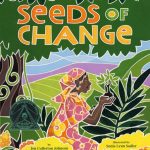Jen Cullerton Johnson, author of Seeds of Change and The Story of Environmentalist Wangari Maathai, is visiting Kenya to explore the legacy of Wangari Maathai. Along with a group of educators, scientists, and community partners, they are tracing the footsteps of Wangari’s life; planting trees, visiting elementary students, meeting with community members, attending university-led mini-lectures, and participating in environmental and wildlife conservation field experiences. Jen shares more about this experience in today’s post.
In 2010 and 2020 respectfully, Lee & Low published my books Seeds of Change and The Story of Environmentalist Wangari Maathai. Both books are biographies of Wangari Maathai, the first African woman to win the Nobel Prize (2004) for her work on the environment and women’s rights.
As the founder of the Green Belt movement, Wangari Maathai saw the devastating effects of deforestation in Kenya. Foreign companies in Kenya cut down forests to make way for tea and coffee plantations. Without trees, animals had fewer shelter and food sources, and rivers dried up because tree roots no longer held the soil in the riverbanks. Women and girls had to walk miles for firewood, and their water sources dwindled. Wangari Maathai saw that all things are connected. In 1977, with other women, she founded the Green Belt Movement where she taught women and girls how to plant and care for a tree. If the tree survived, the women and girls would be paid for taking care of the tree.

Today, the Green Belt Movement has grown and become an international symbol for the environment and women’s rights. Yet, no matter how known the organization becomes, it continues to teach communities around the world about planting and caring for trees.
Meeting with the Green Belt Movement women in Ihithe, Nyeri, and Wangari Maathai’s hometown, taught me firsthand about planting trees.
“First, you must grow the seedling with care, paying attention to water and sunlight. At the seedling stage is when the tree is most vulnerable and requires care,” Teresa Wawareu instructed. She has worked for the Green Belt Movement for 20 years and has planted thousands of trees. “A tree is viable if it survives for three years. During those three years, we care for the trees like they are our children. After that time, the tree grows on its own,” she explained.

Before Wangari Maathai passed away in 2011, she made significant strides in bringing youth into the environmental movement. In Ihithe, several youths joined in planting trees. When asked about their tree planting experiences, many offered that planting trees helped them connect with their families and their communities.
“I feel proud of our trees,” Joi Kangeri, a fifth-grader offered. “I know that our trees are making a difference in the world.”
Making a difference is what the Green Belt Movement is doing by planting trees and sharing their message. We too as educators and parents can join in and join with them to help save our planet and bring our communities together. To learn more about the book Seeds of Change, the Green Belt Movement, and having your students be part of a friendship Zoom exchange program between Kenya students, contact me at jencullertonjohnson@gmail.com

Jen Cullerton Johnson is a writer, an educator, and an environmentalist with master’s degrees in nonfiction writing and curriculum development. She teaches at both the elementary and college levels in Chicago, where she also conducts writing workshops. Johnson can be found online at jencullertonjohnson.com.









